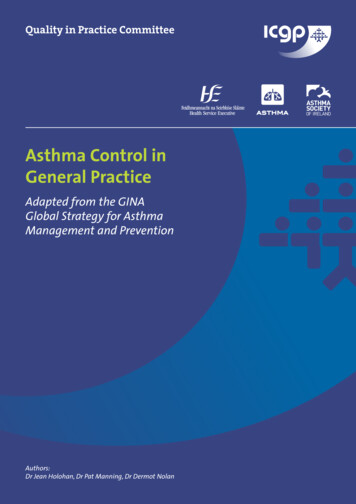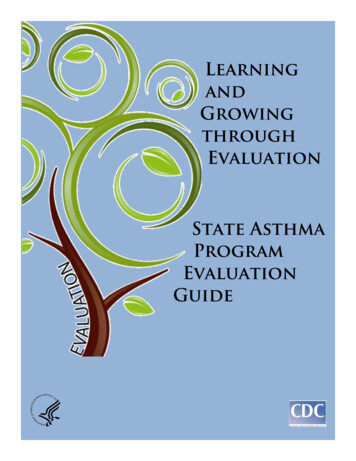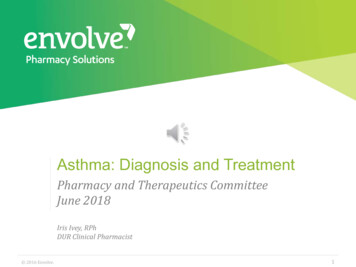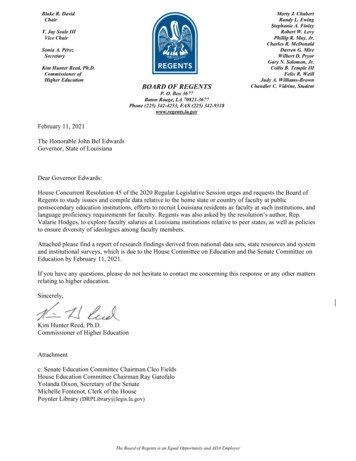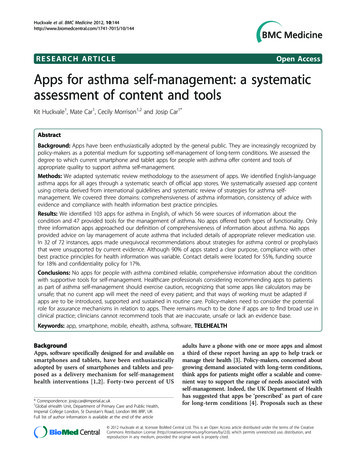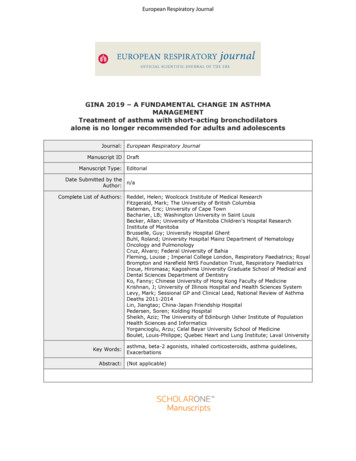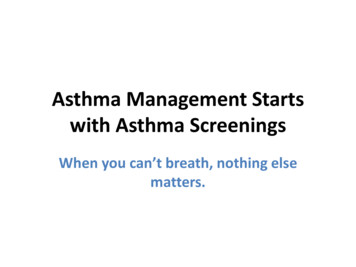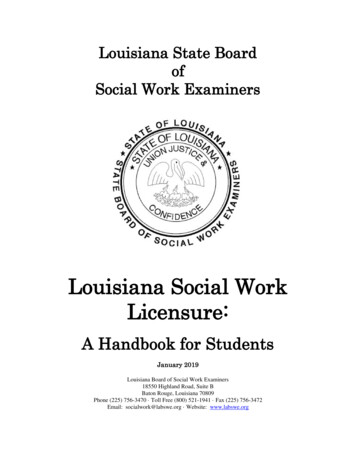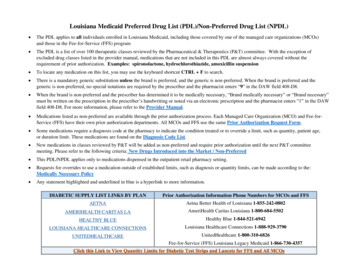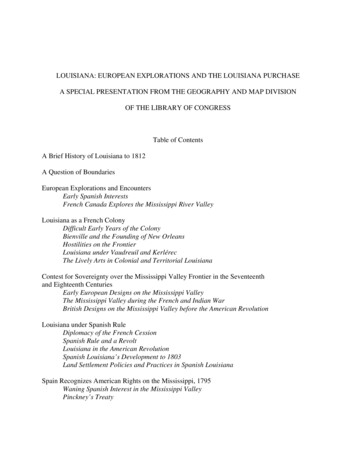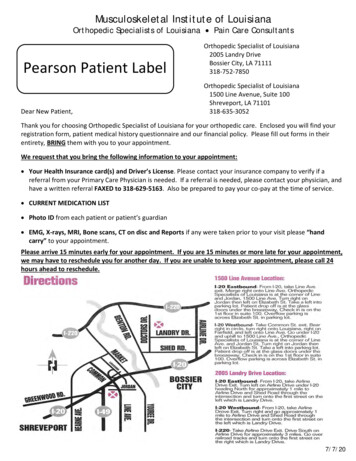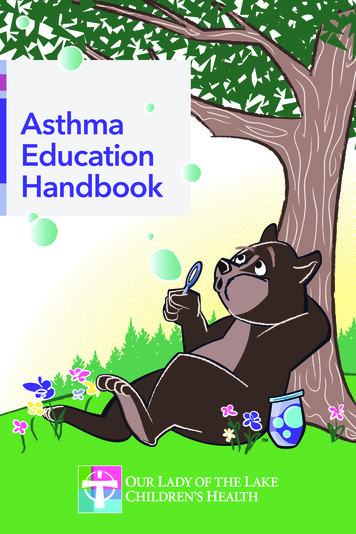
Transcription
AsthmaEducationHandbookTM
TABLE OF CONTENTSYOUR TEAMYour Doctor:What is Asthma?. . . . . . . . . . . . . . . . . . . . . . . . . . . . . . . . . . . . . . . . . . . . . . . . 2Asthma Medicines. . . . . . . . . . . . . . . . . . . . . . . . . . . . . . . . . . . . . . . . . . . . . . 3How to Use Inhalers with a Spacer and Mask. . . . . . . . . . . . . . . . . . . . . . . 6Your Pediatrician:How to Use Inhalers with a Mouthpiece . . . . . . . . . . . . . . . . . . . . . . . . . . . 7Asthma Triggers. . . . . . . . . . . . . . . . . . . . . . . . . . . . . . . . . . . . . . . . . . . . . . . . 8What is an Asthma Action Plan? . . . . . . . . . . . . . . . . . . . . . . . . . . . . . . . . . 10Your Specialist:Understanding Your Cannister Medicine . . . . . . . . . . . . . . . . . . . . . . . . . 13Understanding Your Nebulizer Medicine . . . . . . . . . . . . . . . . . . . . . . . . . 14Understanding Your Asthma Control Test. . . . . . . . . . . . . . . . . . . . . . . . . 16INFORMATIONWhat is a Peak Flow Meter?. . . . . . . . . . . . . . . . . . . . . . . . . . . . . . . . . . . . . 18Our Lady of the Lake Children’sHealth Pulmonology: . . . . . . . . . . . . . . . . . . . . . . . (225) 765-3456Our Lady of the Lake Children’s HealthAllergy/Immunology:. . . . . . . . . . . . . . . . . . . . . . . (225) 765-6834FAQs. . . . . . . . . . . . . . . . . . . . . . . . . . . . . . . . . . . . . . . . . . . . . . . . . . . . . . . . . 19Notes . . . . . . . . . . . . . . . . . . . . . . . . . . . . . . . . . . . . . . . . . . . . . . . . . . . . . . . . 21Our Lady of the Lake Children’s HospitalEmergency Room:. . . . . . . . . . . . . . . . . . . . . . . . . . (225) 765-8853Lake After Hours Kids: . . . . . . . . . . . . . . . (225) 765-KIDS (5437)ololchildrens.orgAsthma Education Handbook 1
WHAT IS ASTHMA?ASTHMA MEDICINESAsthma is inflammation (swelling) in the lung airways. Even when your child isnot having an attack and looks well, the swelling is present. Asthma often runs infamilies, especially those with eczema or allergies.What types of medicine are used to treat asthma?Asthma can be well controlled with the right medicines. Asthma medicines aresafe and work well when taken correctly. The medicines are not addictive andyour child will not become dependent on them. Please bring your medicines andspacers to doctor visits to review and make sure you’re using them correctly.There are two main asthma medications:1. Rescue medicine or quick-relief medicine2. Controller medicineInflamed bronchial tubeof an asthmaticswollen asthma airwayWhat RESCUE or QUICK RELIEF Inhaler do you use?Normal bronchial tubenormal airwayAsthma causes THREE things that make it hard to breathe:1. Swelling inside the airways2. Tightening of the muscles surrounding the airway3. Increase in mucusWhat are Asthma Symptoms? Coughing (often worse at night) Fast breathing/chest tightness Noisy breathing (wheezing) Chest caving in (retractions)Albuterol is a drug that relaxes the muscles around the breathing airway. It opensthe airway within minutes. It rescues your child, but does not help the swellingin the bronchial tube. This medicine is your “quick relief medicine.” Always haveAlbuterol available.Using quick relief medicine more than two times in a week may be a sign yourchild’s asthma is not controlled. Please contact your doctor to discuss.Some children also need quick-relief medication to “pretreat” beforeexercise or active play. This should allow exercise or active play without anyasthma symptoms.Circle the medicine you use to quickly relieve your asthma symptoms.SHORT-ACTING BETA2-AGONIST BRONCHODILATORSRelax tight muscles in airways and offer quick relief of symptomssuch as coughing, wheezing and shortness of breath for 3-6 hours.Other early warning signs2 Scratchy, itchy throat Tummy hurts, throwing up Runny nose, sneezing Red, watery eyes, dark circles under eyes Feels tired, quiet, lays around Change in behavior — can’t sleep, decreased appetiteAsthma Education Handbook DOSE INDICATOR GENERIC AVAILABLEDISEASE STATES: ASTHMA COPDProAir HFAProAirRespiClick Proventil HFAVentolin HFAXopenexHFA albuterolsulfatealbuterol lfatelevalbuteroltartrateAsthma Education Handbook 3
What CONTROLLER medicine do you use?Controller medicine controls swelling of the airways. Swelling is the silent part ofasthma which can be dangerous and cause death. This medicine has to be takenconsistently every day to work.Have your child take it when they wake up and before they go to sleep, even whenthey are not sick. The medicine does NOT work if your child misses a dose.Tell your doctor if your child still uses quick relief or rescue medicine while takingcontroller medication regularly.COMBINATION MEDICATIONSContains both inhaled corticosteroid and long-acting beta2-agonist (LABA). DOSE INDICATOR GENERIC AVAILABLEAdvair Diskus Advair HFAfluticasone propionateand salmeterolinhalation powderfluticasone propionateand salmeterolxinafoate100/50, 250/50, 500/50DISEASE STATES:45/21, 115/21, 230/21Circle your controller medicine.Breo Ellipta 100/25 mcg,200/25 mcgReduce and prevent swelling of airway tissue; they do not relievesudden symptoms of coughing, wheezing or shortness of breath. DOSE INDICATORArmonAir RespiClick Alvesco HFAfluticasone furoateinhalationpowderFlovent Diskus Flovent epropionate50 mcg, 100 mcg,250 mcg 100 mcg, 200 eDISEASE STATES:Arnuity Ellipta 55 mpg, 113 mpg,232 mpg80 mcg,160 mcg4 GENERIC AVAILABLE44 mcg,110 mcg,220 mcgAsthma Education Handbook ASTHMAAsmanex HFAAirDuo RespiClick 55/14 mcg,113/14 mcg,232/14 mcgfluticasonefuroate andvilanterolinhalationpowderDulera 100/5, 200/5mometasone furoate andformoterol fumaratedihydrateSymbicort (HFA)80/4.5, 160/4.5budesonide andformoterol fumaratedihydrate COPDAsmanex Twisthaler 110 mcg, 220 mcgmometasonefuroatePulmicortFlexhaler wderController medicine should not be used for symptoms of an asthma attack.INHALED CORTICOSTEROIDS ASTHMAmometasonefuroateinhalationpowderQVAR Redihaler 90 mcg, 180 mcg40 mcg, 80 onateAsthma Education Handbook 5
HOW TO USE INHALERS WITH A MOUTHPIECEImportant Tips for Children Under 9 Years OldImportant Tips for Children 9 Years and Older6HOW TO USE INHALERS WITH A SPACER AND MASK Always use a spacer device with a face mask. Always use a spacer device. Always sit or stand. Always sit or stand. Clean weekly in warm soapy water and air dry. Clean weekly with warm soapy water and air dry.Asthma Education HandbookAsthma Education Handbook 7
ASTHMA TRIGGERSAn asthma trigger is something that makes your asthma flare up. Work with yourdoctor to learn your child’s triggers.Use this checklist to check boxes next to what could trigger your child.LL Tobacco SmokeLL Do not allow smoking in the home or carLL Call 1-800-QUIT-NOW for confidential support, coaches, patchesand gum. Our Lady of the Lake also offers programs to help youquit. Visit ololrmc.com to learn more.LL Dust MitesLL Dust mites are tiny bugs you cannot see that live in the carpet,bedding mattresses and stuffed animalsLL Use dust-proof mattress and pillow covers with zippersLL Wash sheets and blankets once a week in hot waterLL Use containers with lids to store books and toysLL Do not keep stuffed animals on the child’s bed and wash themweeklyLL Dust regularly with a damp cloth and vacuum carpet and fabriccovered furnitureLL If possible, remove carpetLL Use a Hepa Filter system in major roomsLL Vacuum with a vacuum cleaner using a Hepa FilterLL Pet DanderLL Pet dander is the flakes of skin that come from animals with fur andfeathers.LL When possible, keep pets with fur and feathers out of the home.LL Keep pets out of child’s bedroom and sleeping areas.LL Keep pets off of fabric-covered furniture.LL Wipe fur off of furniture.LL CockroachesLL Dried droppings from a cockroach can trigger asthma.LL Store open food in closed containers (do not leave food out).LL Empty the trash every day or keep in a closed container.LL Clean all food crumbs and spills right away.LL Avoid sprays by using roach baits and traps. If spraying isnecessary, do not spray when the child is home.LL MoldLL Dry areas that are damp (especially in basements and attics)LL Fix leaky faucets, pipes or other sources of water.LL Clean mold with bleach.LL If possible, use dehumidifier.LL Strong OdorsLL Try to keep children away from strong odors and sprays such asperfume, cleaning products, bleach, incense, hair spray and paint.LL ExerciseLL Your child should be able to be active without symptoms.LL See your child’s doctor if they have asthma symptoms withexercise, play or when working hard.LL Respiratory Infections — Colds and the fluLL Wash hands often.LL Get a flu shot every year.LL Cough medication is NOT recommended.LL IrritantsLL Exhaust from cars, buses or other automobiles.LL Emotions - Laughing and cryingLL Take slow, deep breaths in and out through your nose.LL Use quick relief medicine if needed.LL Use a Hepa Filter system in major rooms.LL Wash pets weekly.8 Asthma Education HandbookAsthma Education Handbook 9
WHAT IS AN ASTHMA ACTION PLAN?The doctor should give you a written plan to take care of your child with asthma.It tells you how to take your asthma medicines and what actions to take whensymptoms flare-up. Everyone with asthma should have an asthma action plan.This plan is separated into three sections. This is the most important paper givento you.GREEN ZONEThe first section is the green zone. The green zone meansyour child is having no symptoms. If your child needs acontroller medication for swelling it would be located inthe green section. This medication must be taken everyday consistently to work. It is very slow acting.YELLOW ZONEThe next section is called the yellow zone. The yellowzone means your child is having symptoms. The rescue orquick relief medication to loosen the tight bands will belocated in the yellow section.RED ZONEThe last section is called the red zone. The red zonemeans your child is having severe symptoms. If your childneeds the rescue medication sooner than four hours theyneed to see a doctor.The school nurse, coach, and other caregivers will need a copy in order to knowwhat to do for your child if an attack happens at school. The nurse will also needthe proper papers signed to give your child their medication at school. The nursewill need your child’s rescue medication.EXAGREEN ZONEYou have all of these: Breathing is good No cough or wheezeMPL Can work/play Sleeps all nightEDOING WELLOther Instructions:Take these long-term control medicines each dayIf you have exercise induced asthma use the pre-exercise medication 15 minbefore exercise.YELLOW ZONEYou have any of these: Cough Wheeze Tight chest Coughing at nightASTHMA IS GETTING WORSEOther Instructions:FIRST: Take RESCUE INHALER Albuterol (Proair, Ventolin, Proventil) orLevalbuterol (Xopenex) 4 puffs every 20 minutes until symptoms resolve(MAXIMUM of 3 treatments)SECOND:A. If your symptoms (and peak flows) return to Green Zone 20 minutes after thelast albuterol treatment:1. Take the Albuterol (Proventil,Ventolin) inhaler 4 puffs every 4 hours for 1 or2 days2. Call your doctor if not better after 1-2 daysB. If your symptoms (and peak flows) do NOT return to Green Zone 20 minutesafter the last Albuterol treatment3. Take RESCUE INHALER 4 puffs one more time AND call your doctor NOW!4. Follow RED ZONE instructions if unable to reach doctor after 20 minutescontinued on next page10 Asthma Education HandbookAsthma Education Handbook 11
UNDERSTANDING YOUR CANNISTER MEDICINERED ZONEYou have any of these: Medicine is not helping Breathing is hard and fast Nose opens wide Can’t walk or talk well Ribs showMEDICAL ALERT!Other Instructions:FIRST:Take RESCUE INHALER Albuterol (Proair, Ventolin, Proventil) or Levalbuterol(Xopenex) 6 puffs NOW!SECOND:Call 911 or go to the closest ER NOW!Take RESCUE INHALER 6 puffs every 20 minutes until paramedics/ER arrival1. Inside the medication canister is filler (or Propellant), the medication isfloating at the top of this filler. SHAKE the canister five seconds beforeeach spray.2. When used for the first time: Spray times in the air. See chart belowfor number of times to spray your inhaler. REPEAT IF NOT USED FORtwo weeks3. Always use a spacer.CHECKLISTDo you have an asthma action plan at home?Do you have a rescue inhaler at home?Do you have an asthma action plan at school/daycare?Do you have a rescue inhaler at school/daycare?12 Asthma Education Handbook4. Keep the spacer clean. Wash weekly in warm soapy water and air dry.MEDICATIONFIRST TIME TOGIVE MEDICINEREPRIMEVENTOLIN4 SpraysIf not used for 2 weeksPROAIR3 SpraysIf not used for 2 weeksPROVENTIL4 SpraysIf not used for 2 weeksXOPENEX4 SpraysAfter not using for 3 daysFLOVENT4 Sprays1 Spray after dropping or 7 days of notusing itDULERA4 SpraysIf not used for 5 daysADVAIR4 Sprays2 Sprays after dropping or 4 weeks of notusingQVAR2 SpraysAfter 10 days of not usingSYMBICORT2 SpraysAfter dropping or 7 days of non useROUND DISCDry PowderDo fast inhale and holdbreath for 10 secondsRINSE OUT YOUR MOUTH AFTER.Never blow into the dry powder.Asthma Education Handbook 13
UNDERSTANDING YOUR NEBULIZER MEDICINE14 Asthma Education Handbook19Asthma Education Handbook 15
UNDERSTANDING YOUR ASTHMA CONTROL TESTToday’s Date:Patient’s Name:Childhood Asthma Control Test for children 4 to 11 years.Step 1 Let your child respond to the first four questions (1 to 4). If your child needs help reading or understanding the question, you may help, but letyour child select the response. Complete the remaining three questions (5 to 7) on your own and without letting your child’s response influenceyour answers. There are no right or wrong answers.Step 2 Write the number of each answer in the score box provided.Step 3 Add up each score box for the total.Step 4 Take the test to the doctor to talk about your child’s total score.19or lessHave your child complete these questions.1. How is your asthma today?Today’s Date:Patient’s Name:How to take the Childhood Asthma Control TestIf your child’s score is 19 or less, your child’s asthmasymptoms may not be as well controlled as they could be.NOTE: If your child’s score is 12 or less, this may be anindication that their asthma is very poorly controlled.Please contact your child’s healthcare provider rightaway (if this is the case).There may be more you and your child’s healthcare providercould do to help control your child’s asthma symptoms.Asthma Control Test is:A test for people with asthma 12 years and older—it provides a numerical score to help assess asthma control.Recognized by the National Institutes of Health (NIH) in its 2007 asthma guidelines.1Clinically validated against specialist assessment with spirometry.2PATIENTS:SCORE1. Write the number of each answer in the score box provided.2. Add up the score boxes to get the TOTAL.3. Discuss your results with your healthcare provider.1. In the past 4 weeks, how much of the time did your asthma keep you from getting as much done at work, school or at home?0123Very badBadGoodVery goodAll ofthe time1Most ofthe time2Some ofthe time3A little ofthe timeOnce or twicea week4None ofthe time54Not at all5SCORE2. How much of a problem is your asthma when you run, exercise or play sports?2. During the past 4 weeks, how often have you had shortness of breath?More thanonce a day012It's a big problem, I can't do what I want to do. It's a problem and I don't like it.It's a little problem but it's okay.It's not a problem.12Yes, most of the time.23 to 6 timesa week33. During the past 4 weeks, how often did your asthma symptoms (wheezing, coughing, shortness of breath, chest tightnessor pain) wake you up at night or earlier than usual in the morning?4 or morenights a week0Once a day33. Do you cough because of your asthma?Yes, all of the time.13Yes, some of the time.12 or 3 nightsa week2Once a week3Onceor twice4Not at all54. During the past 4 weeks, how often have you used your rescue inhaler or nebulizer medication (such as albuterol)?No, none of the time.3 or moretimes per day4. Do you wake up during the night because of your asthma?11 or 2 timesper day22 or 3 timesper week3Once a weekor less4Not at all5Wellcontrolled4Completelycontrolled55. How would you rate your asthma control during the past 4 weeks?01Yes, all of the time.Yes, most of the time.Not controlledat all32Yes, some of the time.No, none of the time.5432101-3 days4-10 days11-18 days19-24 daysEveryday5432101-3 days4-10 days11-18 days19-24 daysEverydaySomewhatcontrolled3TOTALHEALTHCARE PROVIDER:Include the Asthma Control Test score in your patient’s chart to track asthma control.Copyright 2002, by QualityMetric Incorporated.Asthma Control Test is a trademark of QualityMetric Incorporated.7. During the last 4 weeks, how many days did your child wake up during the night because of asthma?543210Not at all1-3 days4-10 days11-18 days19-24 daysEverydayThe Childhood Asthma Control Test was developed by GSK.2NOTE: If your score is 15 or less, this may be an indication that your asthma is very poorly controlled.Please contact your healthcare provider right away if this is the case.6. During the last 4 weeks, how many days did your child wheeze during the day because of asthma?Not at allPoorlycontrolledIf your score is 19 or less, your asthma may not be as well controlledas it could be. No matter what your score, share the results with yourhealthcare provider.Please complete the following questions on your own.5. During the last 4 weeks, how many days did your child have any daytime asthma symptoms?Not at all1References: 1. US Department of Health and Human Services, National Institutes of Health, National Heart, Lung, and Blood Institute. Expert Panel Report 3:Guidelines for the Diagnosis and Management of Asthma (EPR-3 2007). NIH Item No. 08-4051. n.htm.Accessed March 31, 2017. 2. Nathan RA et al. J Allergy Clin Immunol. 2004;113:59-65.TOTALThis material was developed by GSK. 2017 GSK group of companies.All rights reserved. Printed in USA. 818452R0 April 201716 Asthma Education HandbookAsthma Education Handbook 17
WHAT IS A PEAK FLOW METER?FAQSA peak flow meter can help tell you if your child has swelling at home. It measuresthe breath blown out. It cannot diagnose asthma, but it can be used to monitorasthma at home. It is important to blow into the peak flow meter with great efforteven when not feeling well.Can asthma be cured?Use your meter every day and write down the best number of three attempts.Peak flow should not be a substitute to using your inhalers.Green zone is 80-100% of best effort, yellow zone is 50-80% of best effort, andred zone is below 50% of the best effort.How to use a peak flow meter Place indicator at the bottom of the scale. Stand up. Take a deep breath. Place the meter in the mouth and close lips around the mouthpiece. Blow out as hard and fast as you can. Write the number you get Repeat two more times Mark the highest of the three numbers you get on your peak flow record.My predicted peak flow is .datea.m.p.m.Asthma cannot be cured, but it can be controlled.What is the goal of asthma treatment?To decrease airway swelling and narrowing so children have fewer symptoms andflare-ups.What is controlled asthma? Symptom free most of the time or not using quick relief medicine morethan twice in a week Able to exercise and play like other children Sleeping through the night without coughing Not missing school or work due to asthma flare-ups Not needing to fill your rescue or quick relief medicine more than twice ayear unless needed for exercise.How can I help my child have controlled asthma? Attend regular doctor visits every three to six months. Asthma is a chronicdisease that can change over time, and your doctor may need to increaseor decrease your medication. Work with your doctor to learn your child’s asthma triggers (things thatmay increase symptoms) and learn how to avoid them. Understand how your medications workHow is asthma diagnosed? By a doctor’s visit, history and physical exam. A spirometry test may be performed. It can help the doctor know moreabout your child’s asthma. It is a simple breathing test than can be doneby the age of four or five years old.Should I give cough medicine when my child coughs?Cough medication is NOT recommended. Remember some kids’ only symptom ofasthma is a cough!My personal best peak flow is .18 Asthma Education HandbookAsthma Education Handbook 19
When do I call the doctor?NOTES Becomes worse even though you have been giving the asthmamedications Is sick enough to miss school because of wheezing Has a fever of 101 degrees by mouth Cannot sleep at night because of wheezing, breathing trouble andcoughing Has a peak flow meter that— Falls into the yellow zone— Does not respond to medicineWhen do I go to the emergency room? His or her neck, chest or ribs sinking in deeply when breathing Trouble breathing, walking or talking Fingernails or lips that turn blue Cannot speak well because he or she is working so hard to breathe Peak flow meter reading that drops after treatment Falls into the red zone on the asthma action planRemember the RULE OF 2 If your child is using rescue medication more than twice in a week If your child is waking up at night more than twice in a month If your child is using more than two canisters in a year If their peak flow drops lower than 20% of their best effortThis may mean their asthma is not being well controlled. Tell your doctor.What about the flu shot?Yes! It is recommended that all children and their families get a flu shot every year.Children with asthma should not get the nasal flu vaccine.20 Asthma Education HandbookAsthma Education Handbook 21
5000 Hennessy Boulevard Baton Rouge, LA 70808www.ololchildrens.orgCHS-1053 (12/18)
55/14 mcg, 113/14 mcg, 232/14 mcg fluticasone propionate and salmeterol inhalation powder Symbicort (HFA) 80/4.5, 160/4.5 Breo Ellipta Dulera 100/25 mcg, 200/25 mcg fluticasone furoate and dih vilanterol inhalation powder budesonide and formoterol fumarate dihydrate 100/5, 200/5 mometasone furoate and formoterol fumarate ydrate
